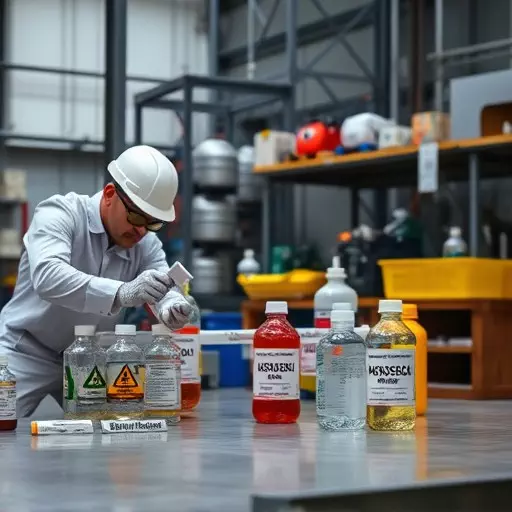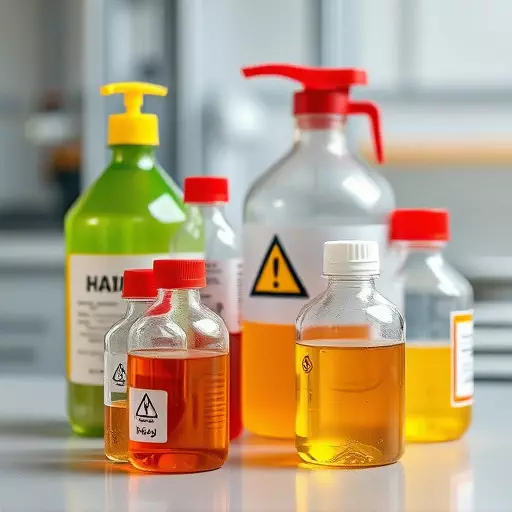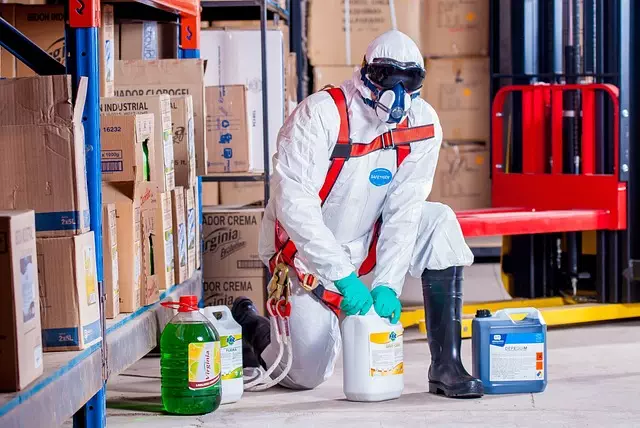The importance of thorough chemical exposure risk management and adherence to industrial hygiene protocols is critical for safeguarding workers' health in environments where hazardous materials are present. This includes the proper identification of hazardous substances, consistent monitoring of exposure levels, and the use of personal protective equipment. Employers must ensure that all chemicals are correctly labeled with their material safety data sheets and provide comprehensive training on handling these materials safely. Engineering controls, such as ventilation systems and air purifiers, play a vital role in minimizing chemical exposure. Regular fit-testing for respirators, rigorous inspections of PPE, and ongoing education on the latest safety practices are essential to maintain a safe work environment. By implementing these strategies, companies can effectively mitigate the long-term health risks associated with hazardous material handling, as demonstrated by case studies highlighting the consequences of inadequate risk management. This approach is not only about compliance but also about prioritizing the well-being of individuals and the community at large.
Long-term chemical exposure can have profound implications on human health, with risks that extend beyond acute reactions. This article delves into the multifaceted impacts of prolonged contact with chemicals in various settings, emphasizing the importance of effective risk management and industrial hygiene protocols for hazardous material identification. Through a comprehensive exploration of common chemicals and their associated health risks, coupled with best practices for protective equipment and personal safety measures, readers will gain a nuanced understanding of how to navigate environments saturated with chemical exposure. By examining case studies that highlight the real-world consequences of inadequate management, this piece aims to equip professionals and individuals with the knowledge to safeguard their health and well-being.
- Understanding the Health Implications of Long-Term Chemical Exposure
- Identifying Hazardous Materials in the Workplace: A Guide to Safety
- The Role of Industrial Hygiene Protocols in Managing Exposure Risks
- Common Chemicals and Their Associated Health Risks
- Best Practices for Protective Equipment and Personal Safety Measures
- Strategies for Effective Risk Management in Chemical-Heavy Environments
- Case Studies: Real-World Examples of Chemical Exposure and Its Consequences
Understanding the Health Implications of Long-Term Chemical Exposure
Long-term chemical exposure can have profound and often irreversible health implications, necessitating a comprehensive understanding of the associated risks. The human body is intricately designed to handle a certain level of environmental toxins, but chronic exposure to hazardous materials can disrupt physiological functions and lead to a spectrum of adverse health outcomes. Chemical exposure risk management is a critical component in mitigating these effects; it involves the implementation of industrial hygiene protocols that are designed to identify, evaluate, and control chemical hazards in the workplace. These protocols are pivotal in safeguarding workers from the pernicious effects of substances such as asbestos, lead, and benzene, which are commonly found in industrial settings. Effective risk management strategies encompass regular monitoring of air quality, personal protective equipment (PPE) usage, and engineering controls to minimize employee exposure. By adhering to these measures, employers can significantly reduce the likelihood of long-term health issues associated with chemical exposure, thereby ensuring a safer environment for all individuals involved in industrial operations. Identifying the types of hazardous materials present is the first step in any risk management plan, as different chemicals pose distinct risks and require specific handling procedures to prevent harm. A thorough understanding of the properties of each substance, coupled with an awareness of the potential routes of exposure—such as inhalation, ingestion, or dermal contact—is essential for effective chemical exposure risk management. Industrial hygiene professionals play a vital role in this process by conducting assessments and designing control measures tailored to the specific chemicals encountered within a given workplace. Through their expertise, these experts help to create a healthier work environment, ultimately protecting workers from the detrimental effects of long-term chemical exposure.
Identifying Hazardous Materials in the Workplace: A Guide to Safety

Long-term chemical exposure in the workplace can have significant health implications for workers. To mitigate these risks, it is imperative to implement robust chemical exposure risk management strategies. A key component of this approach is the identification and proper handling of hazardous materials. Industrial hygiene protocols are pivotal in this regard, as they provide a systematic methodology for recognizing potential health hazards in the workplace environment. These protocols often involve the use of personal protective equipment (PPE), regular monitoring of air quality, and the establishment of clear safety guidelines.
Understanding the various types of hazardous materials and their associated risks is crucial for effective industrial hygiene. This includes not only recognizing the presence of chemicals but also understanding their toxicological properties, the potential routes of exposure, and the possible outcomes of prolonged contact. Training employees in hazardous material identification ensures they can discern between different chemical classes, such as volatile organic compounds (VOCs), heavy metals, and toxic industrial chemicals (TICs). By equipping workers with this knowledge, companies can foster a culture of safety that actively reduces the likelihood of adverse health effects stemming from chemical exposure.
The Role of Industrial Hygiene Protocols in Managing Exposure Risks

The management of chemical exposure risks within industrial settings is a critical task that requires a comprehensive approach. Industrial hygiene protocols play a pivotal role in this context by establishing systematic procedures to identify, evaluate, and control hazardous materials. These protocols are designed to protect worker health and safety by monitoring the levels of exposure to potentially harmful substances. Through regular air sampling, surface testing, and personal protective equipment (PPE) assessments, industrial hygienists can detect chemical exposure risks before they escalate into health concerns. By implementing engineering controls, administrative controls, and safe work practices, these protocols ensure that workers are not exposed to harmful chemicals above permissible limits set by occupational safety standards. The effectiveness of chemical risk management relies on the diligent application of these industrial hygiene protocols, which in turn contributes to maintaining a healthy workplace environment and reducing the incidence of occupational illnesses associated with long-term chemical exposure.
Common Chemicals and Their Associated Health Risks

Long-term exposure to chemicals in industrial settings can have a myriad of adverse health effects. Among the most common hazardous materials workers may encounter are solvents, asbestos, and heavy metals like lead and mercury. Solvents, used widely in degreasing, painting, and cleaning, can lead to respiratory issues, neurological damage, and even cancer. Asbestos, once lauded for its fire-resistant properties, is now recognized as a carcinogen; prolonged exposure can result in mesothelioma, lung cancer, and other serious respiratory diseases. Lead, historically utilized in painting and plumbing, can cause significant neurological harm, particularly in children, affecting cognitive development and leading to behavioral problems.
Effective risk management and industrial hygiene protocols are critical in mitigating the dangers associated with these chemicals. Regular monitoring of air quality, use of personal protective equipment (PPE), and proper ventilation systems are standard practices within occupational health and safety standards. Hazardous material identification is the first step toward implementing control measures; it involves understanding the potential for harm, the routes of exposure, and the specific risks each chemical poses to workers. By adhering to these protocols, employers can significantly reduce the risk of harm, ensuring a safer working environment and promoting the health and well-being of their employees.
Best Practices for Protective Equipment and Personal Safety Measures

When addressing the health effects of long-term chemical exposure, it is imperative to emphasize the importance of robust protective equipment and personal safety measures within industrial settings. Effective risk management begins with the identification and classification of hazardous materials, which form the cornerstone of industrial hygiene protocols. Personnel must be trained to recognize the various types of chemicals they may encounter, understanding their potential toxicity and the associated health risks. This knowledge is crucial for selecting appropriate personal protective equipment (PPE), such as respirators, gloves, and impervious suits, tailored to the specific hazards present.
The selection of PPE should adhere to the hierarchy of controls, prioritizing engineering and administrative controls where feasible, while PPE serves as a supplementary measure when other methods are not entirely effective. Regular fit-testing of respirators ensures that they provide an adequate seal against contaminants, and routine inspections of all PPE prevent potential failures due to wear and tear. Additionally, facilities should implement ongoing training programs for employees to stay informed about the latest industrial hygiene practices and updates on chemical exposure risks. By integrating these measures into daily operations, companies can significantly reduce the risk of adverse health outcomes associated with long-term exposure to hazardous materials.
Strategies for Effective Risk Management in Chemical-Heavy Environments

In environments where chemical exposure is a significant risk, implementing robust industrial hygiene protocols is crucial for safeguarding worker health and mitigating potential hazards. Effective risk management begins with the identification of hazardous materials present, which requires diligent monitoring and adherence to safety standards. Employers must ensure that all chemicals are correctly labeled and their material safety data sheets (MSDS) are readily available for reference. Regular exposure assessments should be conducted to determine the levels at which workers may be exposed and to identify any areas or tasks that pose a greater risk. Personal protective equipment (PPE), such as respirators, gloves, and protective clothing, must be provided and used consistently. Additionally, engineering controls like ventilation systems, air purifying devices, and barriers should be installed to reduce the concentration of hazardous substances in the workplace. Training programs are essential for educating employees on the proper handling, storage, and disposal of chemicals, as well as recognizing symptoms of overexposure and responding appropriately. Continuous monitoring of air quality and exposure levels is necessary to adjust control measures effectively and to make informed decisions regarding the necessity for medical surveillance or interventions when elevated exposures are detected. By integrating these strategies into a comprehensive chemical exposure risk management plan, companies can create a safer work environment and reduce the long-term health effects associated with prolonged exposure to hazardous materials.
Case Studies: Real-World Examples of Chemical Exposure and Its Consequences

The health effects of long-term chemical exposure are well-documented through numerous case studies that underscore the necessity for robust chemical exposure risk management strategies. For instance, in a factory setting, where industrial hygiene protocols are not strictly adhered to, workers may be exposed to hazardous materials over extended periods. One such case involved a group of employees at a manufacturing plant who were repeatedly exposed to a solvent used in their production process. Over time, symptoms such as headaches, nausea, and memory loss became prevalent among the staff. A comprehensive health assessment revealed significant neurological damage, directly linked to the chemical in question. This incident highlighted the importance of rigorous hazardous material identification, handling, and exposure control measures within the workplace. It also underscored the need for ongoing employee health monitoring to detect early signs of adverse effects from chemical exposure. In another case, a community living near an industrial site experienced increased rates of respiratory illnesses and cancers after years of airborne chemical release from the facility. This tragedy could have been mitigated with proper risk management practices and adherence to environmental safety standards, emphasizing the critical role of proactive industrial hygiene protocols in preventing such outcomes. These real-world examples serve as a stark reminder that effective identification, management, and control of chemical exposure risks are paramount to safeguarding public health and maintaining safe working environments.


